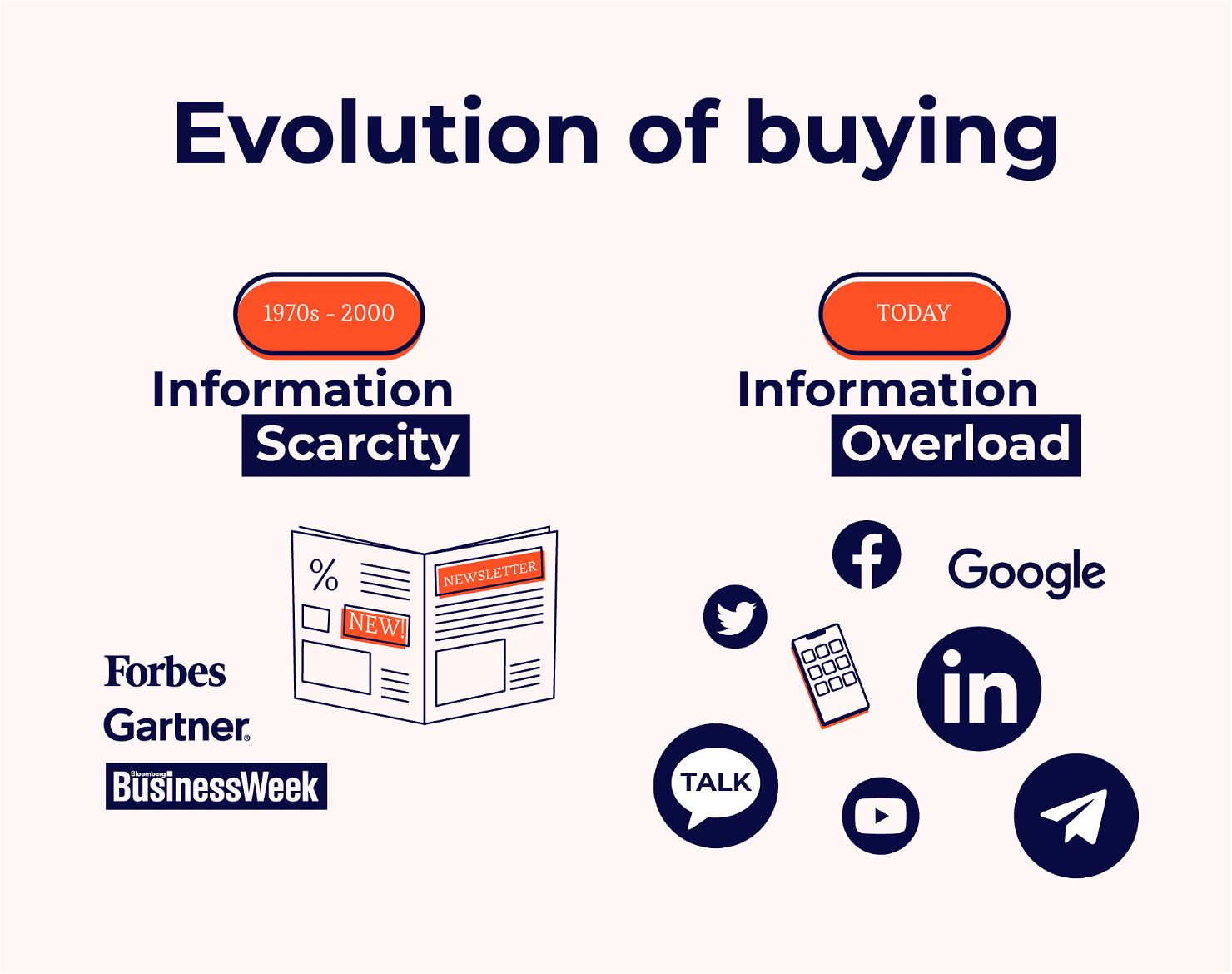This is a snippet of my article that originally appeared on theecommmanager.com:

If you’re looking to stir up some attention for your business, a solid demand generation strategy will help you build an audience and generate excitement around your brand.
If someone walked up to you on the street and suddenly shouted at you, “Hey! Buy my magical supplement. It cures all!” You would probably say, “I don’t believe you. Leave me alone!” That’s also true for new B2B ecommerce brands with pushy ad tactics. You must build a relationship based on trust and establish authority in your niche.
Demand generation is a critical component to your B2B ecommerce brand’s success amidst growing competition and lower barriers to entering the market. On top of that, with the explosion of new channels to transmit a marketing message, it becomes vital to get strategic with your sales and marketing efforts. A comprehensive demand generation strategy will help to position your brand, establish authority, and generate more leads without throwing money down the drain.
As a B2B and startup marketer who has managed several demand generation programs, I will share proven strategies and tactics you can use to build a winning demand gen strategy.
What Is Demand Generation?
Demand generation is the linchpin of B2B ecommerce brand’s marketing strategy because it focuses on building a scalable engine that creates reliable awareness and interest amongst your audience, resulting in a sales funnel with high-quality leads.
Demand gen can make a brand’s marketing messages sound more authoritative and carry more weight with its target market, and ultimately help increase the bottom line by cultivating strong leads that turn into new customers.
Demand gen aims to provide sales with more warm and qualified leads than leads derived from traditional inbound marketing tactics. Demand gen is vital for B2B companies that sell sophisticated or highly technical products with a longer sales cycle because you need to establish credibility. Why should your prospect invest in you over a competitor?
When done right, demand gen aligns sales and marketing teams to build demand for a product/service and clarifies how to do it for every step of the buyer journey.
Demand Generation Vs. Lead Generation: What’s The Difference?
Lead generation
Lead generation is a marketing activity that focuses on turning members of an engaged audience into leads. A lead is someone who has an interest in your brand’s products and services. Leads can be categorized as either “marketing qualified leads” or “sales qualified leads” based on how well they fit the criteria for a qualified buyer and their likelihood to enter a sales deal.
For example, lead generation occurs when a business development representative (BDR) sends a personalized follow-up email to a prospect who recently attended a webinar, offering a free trial. If they accept the free trial, they may be categorized as a marketing-qualified lead and be passed on to sales, who will try to convert the lead into a paid customer.
Demand generation
Demand generation, on the other hand, encompasses not only lead generation but also the entire content strategy and activities needed to build an audience within your demographic and total addressable market (TAM). It involves creating a data-driven marketing funnel and optimizing it over time to engage new leads.
Demand gen requires heavy collaboration and communication between sales and marketing departments. It starts earlier in the buyer’s journey than lead gen because it helps to create awareness about:
- The problem you solve.
- How you solve it.
- Why buyers should trust/choose you.
Why Do New Brands Need A Demand Generation Strategy?
Meet buyers where they are in their journey
A decade or two ago, B2B buyers had far fewer sources of information when it came down to purchasing products online. Thanks to search engines like Google and communities like Reddit, key information has been democratized and decentralized. Whereas companies used to rely on industry analysts like Gartner and Forrester to share their in-depth reports, buyers can now engage directly with other buyers and customers.
Due to the increased streams of information available, the buyer journey is a lot more complicated these days. Marketing teams need to think long-term to orchestrate plays that produce high-quality leads across dozens of touchpoints using the right call-to-action at the right time.

Increase brand awareness
Top-of-funnel awareness is critical to building your brand over time. Think back to the Marketing Rule of 7, which says that a message needs to be heard at least seven times to be effective. The more times someone comes across your brand, the more likely they are to think back to it when facing a problem you can solve.
Demand gen puts systems in place to keep your brand in front of your audience and nurture prospective buyers.
Build relationships and trust
A key element of demand generation is establishing authority and credibility in your space. Target buyers will trust you more when you provide value for free, align your brand with topical experts, and showcase customer success stories. This is because you can show what you know and are capable of instead of just telling.
The more consistently you drive these marketing components into your demand gen strategy, the greater the trust will be.
Generate more leads and revenue
Building awareness, capturing and nurturing leads, and prompting engagement through a deliberate demand generation strategy is essential to driving revenue. A robust demand generation strategy will help you bring in reliable, high-quality leads and grow your business.
You’ll reduce wasted marketing spend, increase lead quality, and consistently hit your quotas.
Reduce customer churn
Retaining customers is far more profitable than replacing them. Demand generation helps to better educate prospective buyers about your product, so they are more informed and likely to make the right choice at checkout. Since they are more confident of your product’s ability to deliver, the likelihood of churning is lower.
Laying The Foundation For Your Demand Generation Strategy
Now that we’ve established what demand generation is and why it’s essential for B2B ecommerce brands, we need to cover the foundation for your strategy before diving in.
There are three things (minimum) you need to take care of before building your demand generation strategy: positioning, success metrics, and tools and processes.
Positioning
Hopefully, before you even started to market your product or service, your team put a lot of thought and energy into positioning your product in the market. A positioning statement should be a sentence or two that clearly defines the problem you’re solving, for who, and why your solution is compelling.
Here is a real-world example of Harley Davidson’s positioning statement:
“The only motorcycle manufacturer that makes big, loud motorcycles for macho guys (and “macho wannabes”) mostly in the United States who want to join a gang of cowboys in an era of decreasing personal freedom.”
Positioning work is essential to ALL marketing because it provides guidelines for building your brand and crafting your messaging. It’s the stake you claim and your brand’s point of view.
Plan how to measure success
Fortunately, demand generation is not as nebulous as branding. It can often be measured quantitatively.
Start by asking yourself, “What’s the main objective of our demand gen efforts?”
Do you want to pump out leads? Well, first of all, how do you define a lead? What is a conversion event to you?
Once you’ve answered those questions, determine how you’ll measure your demand generation strategy’s effectiveness. You might decide on KPIs or metrics like cost per lead (CPL), deal close rate, funnel conversion rates, time to close (TTC), average contract value (ACV), etc.
Configure tools and processes
Demand generation aims to build a sales pipeline by capturing demand and converting leads. You will need to have a website that is capable of both! For example, ensure you set up your pricing page with the ability to buy now or book a demo. To capture demand, you should also have a newsletter subscription form in your website footer to nurture those who are interested but not yet ready to buy.
You’ll need the right tools to capture email subscribers, run lead nurturing programs, and facilitate sales. Use the right ecommerce customer relationship management (CRM) software with email automation capabilities to engage with your subscribers and leads.
